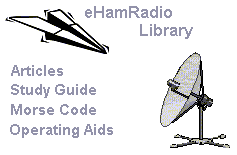Electromagnetic Interference - Radio Frequency Interference
Radio Frequency Interference (RFI) Characteristics
Have you ever wondered why the interference that you receive on the ham bands can
sometimes totally disrupt the intended communications?† Interference
probability is based on the potential power transfer densities involved due to
the proximity of equipment and antenna systems; the various transfer mechanisms, and equipment performance. The electromagnetic transfer mechanisms may vary
depending on modes of operation, propagation conditions, and other variables.† The propagation paths that exist for
signal transfer from the transmitters to a receiver
within the RF environment of a ham band can be numerous.† Antenna-to-antenna coupling parameters may vary depending on antenna gain, directivity, beam width,
side lobes, polarization, separation, propagation conditions of the path (path loss), etc.† † The receiver
characteristics which influence performance include noise, dynamic range,
sensitivity, selectivity (RF, IF), desensitization, adjacent signal
susceptibility, intermodulation, cross modulation and spurious response
susceptibility.† Once a particular type
of interference is determined to be likely, any analysis should be limited to
its most predominate effects.† The following
types of interference are applicable to Radio Frequency (RF) communications
equipment for typical ham radio operations.
1.0 Receiver
Co-Channel Interference
This is defined
as undesired signals with frequency components that fall within the receiverís
RF passband and are translated into the Intermediate Frequency (IF) passband via
the mixer stage.† The interfering signal
frequency is equal to the sum of the receiverís tuned frequency and one half of
the narrowest IF bandwidth.† These
signals are amplified and detected through the same process as the desired
signals; therefore, a receiver is very susceptible to these emissions even at
lower levels.†
Results:† Receiver
desensitization, signal masking, distortion.†
2.0 Receiver
Adjacent Signal Interference
This is defined
as undesired signals with frequency components which fall within or near the receiverís RF passband and are
translated outside of the IF passband via the mixer stage.† These signals must be of sufficient
amplitude to produce non-linear effects within the receiverís RF amplifier or
mixer stages.† Some of the resulting
non-linear response signals may be converted to the IF passband frequency via
the mixer stage where they are amplified and detected through the same process
as the desired signals.† These become similar
to co-channel interference signals at this point. The undesired emissions which are translated outside of the
IF passband may still pass through the remaining receiver stages, if at high
enough levels to survive the out-of-passband attenuation.† They may then be processed by the detector.† The predominant response for this case is
desensitization.†
Results:† Non linear
effects in the RF or mixer stages producing receiver desensitization,
intermodulation and cross modulation.†
3.0 Receiver
Out of Band Interference
This is defined
as undesired signals with frequency components that are significantly removed
from the receiverís RF passband.† High
level signals may produce spurious responses in the receiver if mixed with
local oscillator (LO) harmonics to produce a signal falling within the IF
passband.† The spurious responses result
from the mixing of an undesired signal with the receiverís LO.† The amplitude of these responses is directly
proportional to the level of the undesired signals prior to mixing with the
LO.† The spurious responses in a
receiver usually occur at specific frequencies.† Any other out of band signals are attenuated by the IF
selectivity.†
Results:† An
undesired response created by the mixing of an undesired signal with the
LO.† The undesired signals which mix
with the LO and are capable of being translated to the IF stages are the
spurious response frequencies.† These
frequencies and their interference power levels are a function of the
receiverís susceptibility to these responses.†
4.0
Transmitter Fundamental Emissions
The
transmitterís fundamental output signal includes characteristics of
the power distribution over a range of frequencies around the fundamental
frequency.† These are determined by the
base-band modulation characteristics and are represented by a modulation
envelope function.† The primary
parameter associated with the modulation envelope is the transmitterís nominal
bandwidth (3dB).† This may be derived
from the transmitter modulation characteristics (by Fourier analysis),
measured, or from the manufacturerís specifications.† The power distribution in the modulation sidebands may be
represented by a modulation envelope function showing the variation of power
with frequency.†
5.0
Transmitter Harmonic Emissions
The
main concern with a transmitterís harmonic emissions is the undesired signal
outputs which are harmonically related to the fundamental signal rather than to
other oscillator circuits.† The relative
power associated with the harmonic emissions may be modeled using data for the
particular transmitter type.† However,
since harmonic output power can vary considerably from one transmitter to
another for the same type and model, it should be represented
statistically.† Harmonic emission models
may be derived from statistical summaries of measured data or from
manufacturerís equipment specifications.†
Transmitter spurious emission models for prediction of frequencies above
the fundamental are based on harmonic emission levels.† The modulation envelope must be represented
for harmonics as was done for the fundamental.†
6.0
Transmitter Noise
Transmitter noise includes the output spectrum that is a
result of the thermal noise generated in the driver and final amplifier stages
as well as the synthesizer noise from lower level stages.† This is a broad-band noise; however, it
usually does not cover the immediate modulation sidebands.† The level may be specified as the power per
bandwidth as a function of frequency (dBm/Hz).†
7.0 Transmitter Intermodulation
These
are the undesired signals that result from the local mixing of a transmitterís
output emission with that of another transmitter.† The mixing usually occurs in the non-linear circuits of a
transmitter whose antenna receives a high level of RF from another transmitter
antenna in close proximity.† The mixing
products are radiated by the transmitterís antenna as possible co-channel or
adjacent signal interference signals.†
Part 2: EMI-RFI Transfer Mechanisms
Copyright © 1997-2005 W5AM, eHamRadio, Radioing.com. All rights reserved.
|

